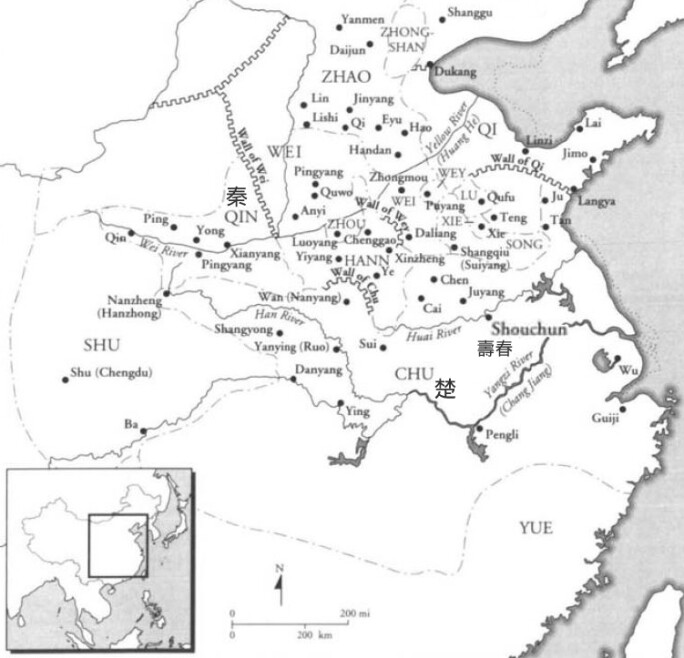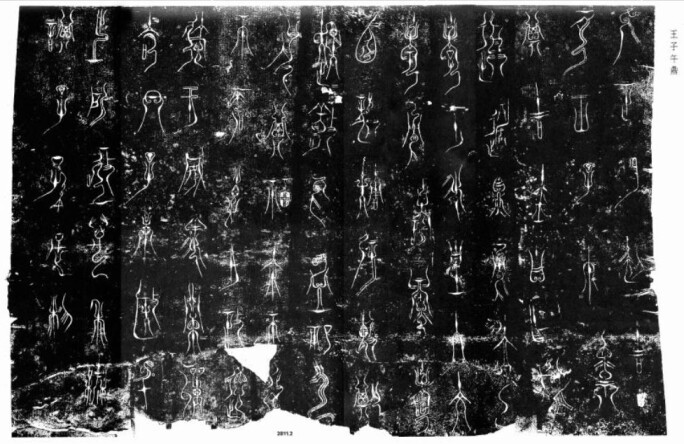The twelve-character inscription superbly cast on the present vessel in an unique artistic calligraphy translates to 'the Chu King Yin Qian made this cast basin, to be used for the yearly chang ritual'. The owner of this bronze, Yin Qian, has been determined by scholars to be King Kaolie of Chu (262-238 BC), whose name often appears in the historical literatures as Xiong Yuan 熊元 or Xiong Wan 熊完. Chang is an ancient ritual ceremony held in the autumn at the ancestor temple by the Son of Heaven and lords of the vassal states. The ritual involved offering fresh grain to ancestors. According to Zhouli (The Rites of Zhou), different ritual bronzes were to be used for ceremonies of different seasons. The autumn and winter seasons are required to use jiayi 斝彝 (grain vessel) and huangyi 黃彝 (yellow vessel).

The present basin belongs to a distinguished set of vessels made by King Kaolie of Chu for the chang ritual. Other vessels from the set include two ding and three fu, all of which, except for one ding, are in the collection of the Palace Museum, Beijing, published in The Institute of Archaeology, Chinese Academy of Social Sciences, ed., Yinzhou jinwen jicheng [Compendium of Yin and Zhou bronze inscriptions], Beijing, 2007, nos 02623, 04549-04551. The Anhui Museum, Hefei, houses the remaining ding, published in Wu Zhenfeng, Shangzhou qingtong qi mingwen ji tuxiang jicheng [Compendium of important inscriptions and images of bronzes from the Shang and Zhou dynasties], vol. 4, Shanghai, 2012, no. 01980. The present basin is the only vessel from the set in private hands.
"In the State of Chu, the broken tips from the hooks of the halberds would be enough to make the Nine Ding."
「楚國折鉤之喙,足以為九鼎」
The death of King Zhao of Zhou during his southern expedition gave opportunity for the rise of the Chu state. The famous story of King Zhuang of Chu (613-591 BC) enquiring about the weight of the Nine Ding 九鼎 possessed by the Zhou king, which was considered as an act of utmost defiance towards the rightful Son of Heaven, was a testament to the superior power of Chu during the Spring and Autumn period. The glorious era of Chu, however, perished with the rise of the Qin empire towards the end of the Warring States period (fig. 1). Qin's dominating power soon debilitated the Chu state through a series of key historical events and battles. King Kaolie of Chu was left with an exhausted state depleted of resources and morale.

圖一 戰國中晚期楚、秦方位圖 地圖原版錄於魯惟一及夏含夷編,《劍橋中國上古史:從文明的起源到公元前221 年》,劍橋,1999 年,頁636
The king's rise to power was challenging. When he was the crown prince, Xiong Yuan was sent by his father King Qingxiang of Chu (298-263 BC) to the Qin state as a hostage for nearly ten years, as an exchange for a peace treaty. When the old king fell ill, Xiong Yuan sought permission from the king of Qin to visit his father. His requests were relentlessly denied. Xiong Yuan's loyal official, Huang Xie 黃歇, who accompanied him to Qin, decided to risk his life to rescue his lord. He dressed Xiong Yuan as one of the messengers from Chu and secretly arranged the prince's escape to claim the throne at home. The new king generously rewarded Huang Xie's loyalty by conferring him the title Lord Chunshen 春申君, who later became one of the famous Four Lords of the Warring States.
King Kaolie of Chu and Lord Chunshen strove to save their falling kingdom from the formidable Qin empire. Chu first ceded land to the Qin state in exchange for a brief period of truce. A transient victory was relished when King Kaolie of Chu, persuaded by Mao Sui 毛遂, a retainer of Lord Pingyuan 平原君 of the Zhao state, dispatched Lord Chunshen to lead the Chu army, joining forces with the Wei and Zhao to save the Zhao capital, Handan 邯鄲, besieged by Qin. The coalition army successfully defeated their enemy. This, however, was not enough to weaken the strength of Qin. In the later years of King Kaolie of Chu, an unsuccessful military campaign was launched out of desperation against Qin by an alliance comprising Chu and other states. This devastating failure forced the Chu state to relocate its capital to Shouchun (today's Shouxian, Anhui province) (fig. 1), and King Kaolie of Chu died shortly after.
"The states of Han, Wei, Zhao, Wei, and Chu struck Qin and conquered Shouling. Qin dispatched troops. The five armies retreated."
「韓、魏、趙、衛、楚共擊秦,取壽陵。秦出兵,五國兵罷」
King Kaolie's successor was King You of Chu (268-228 BC), who, according to several classical texts, such as Zhanguoce (Annals of the Warring States), was in fact the son of Lord Chunshen. Lord Chunshen feared that King Kaolie of Chu may not have heirs, and therefore, presented his pregnant concubine to the king. After King You of Chu, his brother, King Ai of Chu (228-228 BC) came to power. However, he was only able to rule for two months before his brother King Fuchu of Chu (227-223 BC) usurped the throne. In 223 BC, the inexorable Qin army eventually conquered Chu, captured the Chu king, and closed the final chapter of a once-powerful kingdom.

圖二 王子午鼎銘文拓片錄於李伯謙,《中國出土青銅器全集》,卷10,北京,2018年,圖版362
The highly stylized calligraphy cast on this bronze basin is called chuiluzhuan 垂露篆 (the seal script of pendant dew). This unique seal script, with its fluent and graceful strokes, is an embodiment of the sophisticated artistic culture of Chu, and reflects the aesthetics and imaginations of people distant from the central plains of China. Extant bronzes inscribed in this remarkable calligraphy are extremely rare. In addition to the present basin, a set of seven Spring and Autumn period bronze ding from the Chu state, each inscribed with a long inscription in chuiluzhuan (fig. 2), is recorded to be preserved in both the Henan Museum, Zhengzhou, and the National Museum of China, Beijing. One of these ding is published in Li Boqian, ed., Zhongguo chutu qingtongqi quanji / The Complete Collection of Bronzes Unearthed in China, vol. 10, Beijing, 2018, pl. 362.